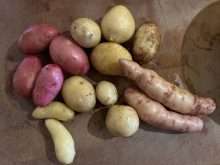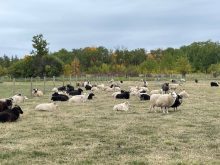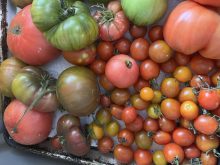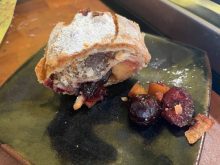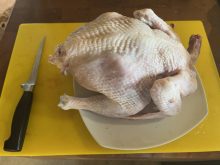When we think of celebrations, such as Christmas, Thanksgiving or even Halloween, we give little thought to the food we eat.
What about that Christmas or Thanksgiving turkey, the centrepiece of the celebration? Did this iconic bird come from Turkey? No way. Turkeys are exclusive to North America — Mexico, United States and Canada. There are two distinct species. One widespread in North America and the other in the Yucatán Peninsula in Mexico. The Mexicans domesticated turkeys a couple of thousand years ago. After the Europeans arrived in the Americas, turkeys were introduced into Europe and were thought by many to have come from Turkey and not Mexico. Turkey breeding is now worldwide and it surprises some to know they come in a range of plumage colours of red, black, white, blue and even bronze. Much of the modern turkey breeding was done in England.
The original wild turkeys were wiped out in Canada by European guns but have now been reintroduced into almost all Canadian provinces including the three Prairie provinces.
Read Also

Claas brings 1000 Series SP forage harvesters to Canada
In mid-August, Claas unveiled its new line of Jaguar forage harvesters at an event in Visalia, California, deep in the heart of that state’s dairy region.

When it comes to the trimmings present at festive occasions, we of course think of corn, beans and potatoes, food that also originated in the Americas, but what else? Foods we now consume and take for granted will surprise some, if not many, of you. Tomatoes are one example. We often hear of ancient Italian tomato recipes — forget it. These recipes aren’t that old since tomatoes were not even introduced to Europe much more than a couple of hundred years ago.
And potatoes. Irish potatoes come from Peru where they grow hundreds of potato varieties. The potato and the Irish didn’t get together until a few hundred years ago. Potatoes range from white- to red-skinned to purple-fleshed.
Maize, beans and squashes
Maize or Indian corn was developed by the Mayan peoples from a wild plant that looked more like wheat than the present-day corn cobs. Present-day corn (Zea mays) originated many thousands of years ago from a teosinte grass-like species in southern Mexico. Today, corn yields worldwide exceed those of both rice and wheat. Grain corn comes in a rainbow of colours from scarlet and blue to black and white.
Beans of all kinds originated in the Americas and have nothing to do with France as in French beans. Varieties include dry beans, snap beans, French beans, pole beans, runner beans, kidney beans, black-eyed beans, navy beans, white beans and more.

All squashes, from the familiar Halloween pumpkin, which comes in a range of colours in addition to the familiar orange, to winter and acorn squashes to ornamental types full of colours, shapes, bumps and lumps, were products of Mexican cultivation.
Peppers, tomatillos, sweet potatoes and sunflowers
Did peppers come from Hungary? No way. All peppers — from green, red and yellow bell types, all of the sweet and hot types and even the white “Hungarian” types — originated on this continent.
Tomatillos, which are green or purple, golf ball- to grape-sized, tomatoes covered in a husk are the key ingredient in chili.
Sweet potatoes come from Central and South America, and they come in a range of colours — red, purple, yellow and white. Sweet potatoes were domesticated some 5,000 years ago. The orange type is called a “yam” and can be substituted for pumpkin pie, called sweet potato pie.

The sunflower family is widespread in North America in annual and perennial types. It was domesticated in Mexico thousands of years ago but surprisingly commercialized in Russia.
Vegetables, fruit, flavours and flavours
Now I have covered a lot of crops that originated from the Americas, but have I dealt with all of the vegetables, fruits, flowers and flavours? No way.
For expediency, I will list the remaining vegetables and grains of the Americas:
- Amaranth is a vegetable or grain.
- Cassava is a huge worldwide staple — tapioca.
- Chia is now a fashionable but major Mexican food grain.
- Quinoa (keen-wah) is now a new wonder grain on the Canadian Prairies.
Jerusalem artichokes are really North American perennial sunflowers grown for the production of fructose. The tubers may be eaten as hardy vegetables. The name Jerusalem is a mystery.
Wild rice is a North American delicacy yet to be domesticated but frequently harvested.
Peanuts, called ground nuts in Europe and Africa, are not nuts at all. They are legumes in the pea and lentil family developed just south of the border by the Indigenous populace.

I must include fruits and I am sure there will be lots of surprises for you. For example, dragon fruit is not from China. It originated in Central America but is now grown in huge acreages in southern Asia, yielding more than 10 tonnes an acre. Coupled with this are the fruits of many cacti and cacti themselves, which are consumed as food. In nature, all cacti are confined to the Americas.
Agave is a big, spiky-leafed, cactus-like plant but is actually a monocot species, which gives us sugars as well as tequila, Mexico’s famous major liquor export.
Avocado, an “in” fruit for the health conscious, is a native of Central Mexico.
Who can celebrate without chocolate? Cacao is the most-gifted food product ever produced and is a plant of Central and South America. It’s candy that can keep you awake and is perhaps addictive.
When you think of chocolate and festivities, you also think of nuts. Both the expensive cashew and Brazil nuts originated in this hemisphere, where both were harvested in the wild in Brazil.
I will wind up with some fruits that may be of surprise to many. Papayas and pineapples are fruits associated with Hawaii, but both of these fruits were cultivated by the Indigenous peoples of South America before spreading worldwide.
Chewing gum and rubber both originated from trees cultivated in Central and South America, as did many other exotic products from unusual fruits to balsa wood.
I haven’t finished yet, since there are more surprises at least for some of you. The most common Christmas decoration after the Christmas tree is the poinsettia, which now comes in many colours. This plant was named after a U.S. ambassador to Mexico, Joel Roberts Poinsett. Poinsettias grow wild in Mexico, in particular, though I have seen them in the wild in Florida. And the exotic dahlia also originated in Mexico.
Lastly, who doesn’t like vanilla? Flavourful vanilla beans are derived from the vanilla orchid. It was for years the secret of the Aztecs before the Spanish arrival in the Americas. Vanilla is now one of the world’s most popular flavours and its many orchid species are grown worldwide for that very distinctive flavour.
Now, when you sit down to your Christmas or other dinner feast, look at the food contribution of the Americas. For this feast, we owe full credit to the Indigenous peoples of the Americas who undoubtedly were expert farmers and food growers long before the European arrival in the “New World.”
Just think, many of these phenomenal foods of the Americas are now critical worldwide commodities available globally.




